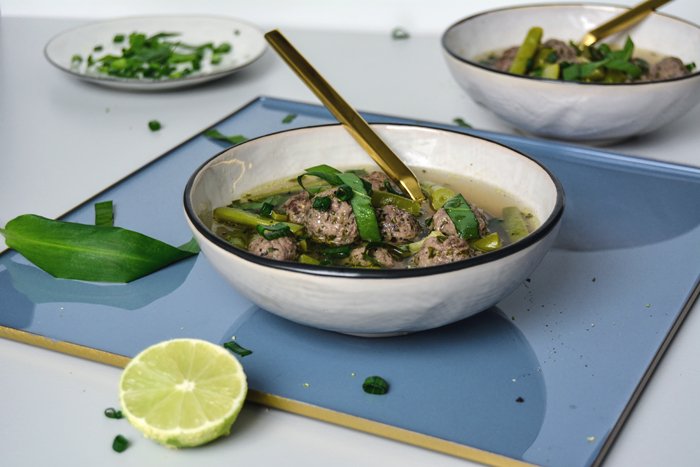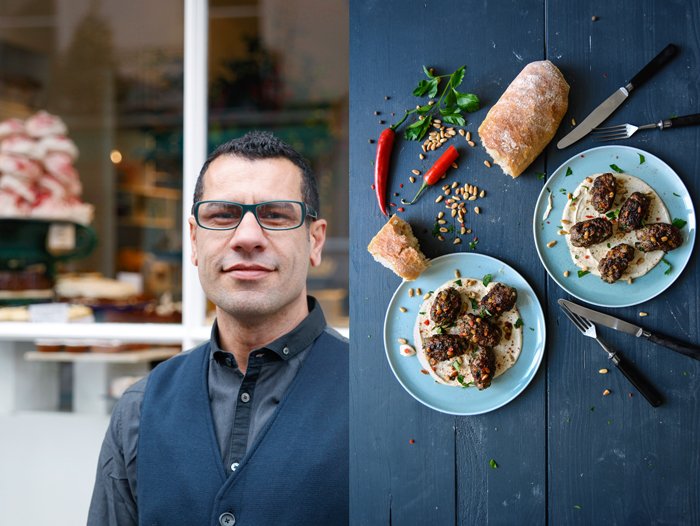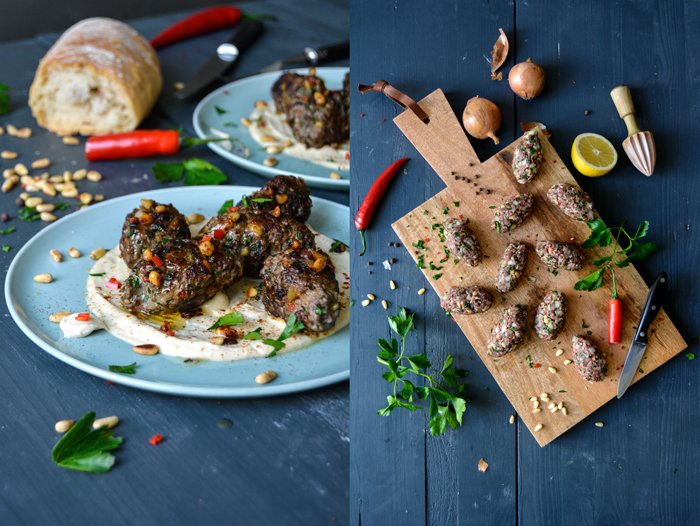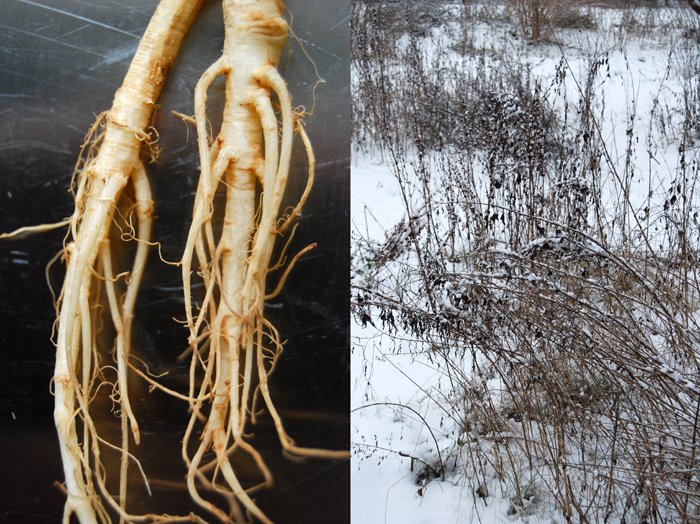Green Minestrone with Lime-Arugula Meatballs
Sometimes I am asked by a reader to come up with a certain recipe. Quite often it's a dish connected to a childhood memory of theirs, a food experience saved many years ago, and now they're hoping to find this specific flavour again. But it's a tricky thing, it's almost impossible to relive something as an adult and expect the same satisfaction that we felt back then when we were young.
I used to love Dutch coconut sheets for breakfast, which is as weird as it sounds. This is compressed dessicated coconut, pressed into thin sheets and, to make it even more appealing, they were either pink or pale white. I was obsessed with them. After a culinary break from this delicacy, I tried them again years later and I was so disappointed. But there's another Dutch classic, which still lives up to my memories, and I enjoy it with the biggest passion whenever I pull it out of my oven: sticky honey cake.
At the end of this winter, I got asked to share a traditional German hot chocolate recipe, which my reader, who lives in the US, connects with the time he spent in Germany as a child. Somehow, I never felt in the mood for it, and my hot chocolate is also a rather simple creation made of milk, unsweetened cocoa powder, and ground cinnamon and cardamom, which is not a traditional German take on this drink. I'm sorry, I'll try to write about it next winter.
But last week, someone dropped a comment on Instagram, telling me that I haven't made a soup in a long time - and this person was right! She lives in Asia and asked for a soup that she can have with her morning rice. I don't think that someone who lives in Asia, needs a German girl to tell her how to make a fragrant broth with ginger, spices, and lemon grass, so I thought about something that I could share from my background. Our summers spent in Malta made me fall for minestrone, and when I cook this warming soup with just green vegetables - like fresh beans, peas, and zucchini - it tastes like spring. To turn it into a full lunch, I add tiny meatballs refined with lots of chopped arugula and lemon zest. The strong aroma of the citrus fruit reminds me of the Mediterranean but at the same time, it adds the same lemony freshness that you know from a clear broth made with ginger. Enjoy!
Green Minestrone with Lime-Arugula Meatballs
Serves 2-4
For the meatballs
ground beef 400g / 14 ounces
fresh arugula leaves, finely chopped (with a knife or in a blender), 1 large handful / 50g
zest of 1 lime (1 heaping teaspoon)
garlic, crushed, 2 cloves
fine sea salt 1 teaspoon
a generous amount ground pepper
For the soup
olive oil
garlic, cut in half, 1 clove
green vegetables (a mix of trimmed green beans, peas, and zucchini), beans and peas cut into bite size pieces, about 350g / 12 ounces
vegetable broth, hot, 1l / 4 1/4 cups
freshly squeezed lime juice 1 tablespoon
bay leaf 1
fine sea salt
ground pepper
For the topping
ramp leaves, thinly sliced, 2 and / or spring onion, thinly sliced, 1
For the meatballs, in a large bowl, combine the ground beef, chopped arugula, lime zest, garlic, salt, and pepper and mix until well combined. Wet your hands and form the mixture into tiny meatballs.
For the soup, in a large saucepan, heat a splash of olive oil over medium heat. Add the garlic and cook, stirring, for about 1 minute. Add the vegetables, stir, and cook for 1 minute. Add the broth, lime juice, and bay leaf, season with salt and pepper to taste, and bring to the boil. Add the meatballs and bring to the boil again. Reduce the heat to medium, cover with a lid, and simmer for 4 minutes. Split 1 meatball to check if it's done. Season the soup with salt, pepper, and additional lime juice to taste.
Serve the soup in deep bowls, sprinkled with ramps and / or spring onion, and enjoy warm.
meet in your kitchen | Sami Tamimi's Kofta b'siniyah with Tahini Sauce
If you love cooking and cookbooks, you've probably come across Sami Tamimi's name, either on the cover of Ottolenghi: The Cookbook or Jerusalem - both award-winning bestsellers. But who is the man who co-wrote these beautiful recipe collections and started some of the most talked about restaurants on the London food scene together with his friend from Israel? While the whole world seeks fame and attention, what drives a man to stay in the background and concentrate on what he loves the most: to cook and create recipes? The more I got to know about Sami, the more I understood his decision to be the chef in the kitchen and not the star in the spotlight.
Growing up in the Old City of East Jerusalem and feeling the restrictions of life in a traditional Muslim family, he left home at the age of seventeen and headed to Tel Aviv. The ambitious young man worked hard and became a chef at one of the country's best restaurants. But Sami was hungry, he wanted to learn and evolve even more: London was next and with it the beginning of a beautiful story of friendship, great food, and success. A story of two men, whose ideas, dreams, and creativity are inseparably woven into each other.
Sami and Yotam first met at Baker & Spice in London, where Sami had developed a food concept quite similar to the one we know from the Ottolenghi restaurants in Islington, Belgravia, Notting Hill, and Spitalfields. Lusciously filled platters of Middle Eastern and Mediterranean dishes, so pleasing to the eyes that one can't help but stop at the first glance. You might not be hungry, but after a quick look through the large windows you'll fall for the tempting displays - they seem to call your name.
Yotam must have felt the same when he passed the restaurant back in 1999. He hopped off his scooter and started talking to Sami. They got along well straight away, so he joined him in the kitchen, and became responsible for the pastry. What happened next is one of the many reasons I love life: a simple idea became reality through hard work and dedication. They decided to open their own place and put their individual skills together to make it happen. The rest is history. In its honesty, Sami's view of the story touches me: “It was Yotam’s vision and his dream. The work was his. The stake was his. I didn’t have money to invest. He risked everything he had. A few years later, I became a partner, but regardless of the cookbooks we do, regardless of our friendship, I’m still working for Yotam. He’s my boss”. But as much as his friend was the visionary, in the end it was also Sami's creative concept for food, which became what we know as Ottolenghi today. These two men, aware of their individual strengths, put it all together and turned it into something greater.
Having cooked and baked with Jerusalem, enjoying it every time I pull it off my shelf, it felt even more exciting to choose one of the recipes from the book together with Sami to share with you. We didn't manage to meet in London, but cooking his kofta here in Berlin, working on the interview with him, and learning so much about and from this inspiring man, made me feel once more that the kitchen is often the best place to get to know someone.
I made Sami's kofta and I loved it. It was nothing less than heavenly: the little oval meatballs are juicy, packed with nutty pine, parsley, spicy garlic and chilli. Sami lays them on a tahini-lemon sauce, a smooth and creamy contrast to the fragrant meat. It's one of those dishes that make you wish you had made twice as much.
Here's a great article by Jane Kramer about Yotam and Sami in The New Yorker, which I can recommend if you need a little inspiration for life.
Sami Tamimi's Kofta b'siniyah
Recipe from Jerusalem by Yotam Ottolenghi and Sami Tamimi.
For these kofta, buy your meat freshly minced by your butcher, if you can. The lamb should be shoulder and the beef a good non-stewing cut. If you get the meat from a supermarket or another grocer, cook it through, just to be on the safe side. Finish the dish with butter only if you are serving it straight away and consuming it all at once. Otherwise, leave it out as it sets quickly, which isn't very nice. Serve with pita (I used ciabatta).
Serves 6 / makes 18 kofta
For serving
light tahini paste 150g / 5 ounces
freshly squeezed lemon juice 3 tablespoons
water 120ml / 1/2 cup
medium garlic clove, crushed, 1
sunflower oil 2 tablespoons
unsalted butter or ghee 30g / 2 tablespoons (optional)
sweet paprika, to garnish
fine sea salt
For the kofta
minced lamb 400g / 14 ounces
minced veal or beef 400g /14 ounces
onion, finely chopped, 1 (about 150g / 5 ounces)
large garlic cloves, crushed, 2
toasted pine nuts, roughly chopped, 50g / 2 ounces, plus extra whole ones to garnish
flat-leaf parsley leaves, finely chopped, 30g / 1 ounce, plus extra to garnish
large medium-hot red chilli, deseeded and finely chopped, 1
ground cinnamon 1 1/2 teaspoons
ground allspice 1 1/2 teaspoons
grated nutmeg 3/4 teaspoon
ground black pepper 1 1/2 teaspoons
fine sea salt 1 1/2 teaspoons
If the tahini-lemon sauce starts to curdle, slowly add more water and continue whisking or pulsing it in a blender until smooth.
Put all the kofta ingredients in a bowl and use your hands to mix everything together. Now shape into long, torpedo-like fingers, roughly 8cm / 3" long. Press the mix to compress it and ensure the kofta is tight and keeps its shape. Arrange on a plate and chill until you are ready to cook them, for up to 1 day.
Preheat the oven to 220°C / 425°F. In a medium bowl, whisk together the tahini paste, lemon juice, water, garlic, and 1/4 teaspoon of salt. You can also use a blender or food processor. The sauce should be a bit runnier than honey; add 1-2 tablespoons of water if needed.
Heat the sunflower oil in a large pan and sear the kofta, in batches, over high heat. Sear on all sides until golden brown, for about 6 minutes. At this point they should be medium-rare. Transfer the kofta to a baking dish and cook in the oven for 2-4 minutes (medium or well done). I cooked mine for 8 minutes in the pan and skipped the oven. I spread the tahini sauce on plates and laid the kofta on top, then I continued with the garnish.
Spoon the tahini sauce around the kofta, so it covers the base of the baking dish. Place in the oven for 1-2 minutes to warm up the sauce.
Meanwhile, if you're using the butter, melt it in a small saucepan and allow it to brown a little, taking care that it doesn't burn. Spoon the butter over the kofta as soon as they come out of the oven. I skipped the butter and used the frying juices from the pan instead. Scatter with pine nuts and parsley and finally sprinkle some paprika on top. Serve immediately.
What made you leave Israel and move to London?
I’d been cooking for many years in Israel. After a good time at Lilith, one of the top restaurants in the country, I was beginning to reach my full potential. I knew if I wanted to keep learning and growing I’d need to look further afield. I’d visited London a few times and fallen in love with it so it was the obvious place to go. The political situation was also getting worse by then and the levels of stress were getting higher. I wanted a change from that.
You say you're more into savoury than sweet baking, what do you like about the process of creating savoury recipes? Why do you prefer it to sweets?
I find I have more creative freedom with savoury cooking. Baking and sweet cooking in general is often quite a science: everything needs to be measured for the result to work out. What goes into savoury cooking can change much more, depending on the day and the mood and what you have to hand. I love that freedom. Also, I can’t stand all the flour that gets everywhere! I like my kitchen clean and tidy.
You lived in Tel Aviv for 12 years, a city known for its vibrant food scene, what makes it so special? What do you miss the most about the food in Israel?
I haven’t lived in Tel Aviv for 17 years so the food scene has changed a lot. I guess what makes it vibrant is people’s passion for the food and people often basing their social life around food. There are a lot of young people who travel the world from Tel Aviv and then return with all sorts of knowledge about different cuisines: that makes it a really creative place.
Do you find creative inspiration in the British cuisine? Do you have a favourite British dish?
We have some wonderful products and raw ingredients here, which are a constant inspiration. There are also a few local chefs who I get a lot of inspiration from: Simon Hopkinson and Nigel Slater, to name just two. I’ve lived in the UK for many years now so I have come to love some of the classic British dishes: Apple or pear and rhubarb crumble, beef wellington and so on.
Is it harder or easier to work with a close friend (Yotam Ottolenghi)? How did your friendship change through the experience of writing books and running restaurants together?
Yotam and I started to work together long before Ottolenghi was born. Combining friendship and business is not always a good thing but we’ve been doing it for many years now and have perfected the way of working together without it effecting our friendship. We see each other a lot and are constantly checking in with each other but our day-to-day jobs are very different. Yotam is based in the test kitchen and I am based in the restaurants so our roles are pretty separate from each other.
You've co-written Ottolenghi: The Cookbook andJerusalem, what is your favourite part of the process of writing a cookbook?
For Jerusalem, cooking at home, alone, in my kitchen and then sharing childhood memories and stories sparked from the food was my favourite part. The Ottolenghi: The Cookbook was harder for us: It’s the first child thing, you are making it up as you go along so it took longer to work out what we were doing! Jerusalem was easier technically but harder emotionally.
What advice can you give young chefs?
Being a chef is hard work: the stress levels are high, the hours are long and you don’t get to sit down or sleep much! Before you spend a lot of time and money going to cookery school, people should always do a stint in a commercial kitchen to see whether the job is for them. There is so much more to the job than just making food look pretty! You need to start with passion and love and then add some hard graft and dedication. And then you can start making the food look pretty!
You write poetry in Arabic and you paint, does this bring you relaxation or inspiration?Writing poetry, painting, photography, cooking, it’s all part of the same process, for me: a way of expressing myself, saying something about the world we are living in.
Do you like to cook at home?
Cooking at home is what keeps me in love with food. I cook at home every evening, even after a long day working with food.
Who is your biggest inspiration in the kitchen?
My mother. She was an amazing cook.
Was food, cooking, and eating a big topic in your family while growing up?
Yes, it was. The kitchen was the heart of the house and my family. When we were having breakfast we’d be discussing what to have for lunch. Chats at lunch were about what we were having for supper. Food was always on the go, being prepared or cooked.
What was the first dish you cooked on your own, what is your first cooking memory?
I cooked all the time, from a very young age: I’d be making it up if I said I could remember my first dish!
What are your favourite places to buy and enjoy food in London?
I tend to go to small Middle Eastern shops in west London for my food grocery because the fruit and vegetables come from sunny places and therefore they taste much better, plus I can find all the ingredients for Palestinian cooking.
If you could choose one person to cook a meal for you, who and what would it be?
My mother. Anything she will cook will be delicious.
You're going to have ten friends over for a spontaneous dinner, what will be on the table?
Many dishes to share and lots of food: if it was a Palestinian spread they’d be Maqluba, okra in tomato sauce, Bamieh Bil Zeit and Mujaddara, lentils and rice with lots of fried onions, to mention just three dishes.
What was your childhood's culinary favourite and what is it now?
I love Palestinian food and still do. I also love Japanese, Mexican, Thai and Nordic food.
Do you prefer to cook on your own or together with others?
When I'm at work then of course with others and it's much more fun. But when I’m cooking at home, I like to be alone, with music.
Which meals do you prefer, improvised or planned?
Some days I'll wake up with a dish in mind and then I'll make it but most times I just go to the shops and decide then, according to what I find and what's in season.
Which meal would you never cook again?
I have recently made Turkish Su Böreği or as some call it, water borek. I'll never attempt to do it again. It was so hard and complicated. The end result is delicious but honestly, I can live happily with myself knowing that I've cooked it once in my lifetime and I'll only be ever eating it in Turkey.
Thank you Sami!
Thai Soup and Beef
The past couple of days have brought a lot of snow, turning the world outside into a winter wonderland. Everything is covered by a soft white blanket, which is true magic to me! It looks different, sounds different and it even smells different. Two days ago I had time for a short walk so I went down the road to a tiny park that looks a bit like a secret garden. It's my city hideaway as it seems to leave the noise and bustle outside as soon as you enter the iron gates. The trees and bushes were covered in snow and I had my camera with me, luckily, so I could take some of these wonderful impressions home with me and share them with you.
After walking for a while I started to feel cold and I got in the mood for a warm, spicy broth, a Thai soup. I have all sorts of broth in my freezer. Every few weeks I cook a few litres of vegetable broth to use for soups and risottos, but I also have duck and pheasant broth in stock at the moment. When you have a strong broth you are already well on your way to a good soup. I warmed up the duck broth and added some lemongrass, ginger, fresh chili and coriander. I was really hungry, so I decided to throw in some pointed cabbage and some tiny meatballs mixed with the spices. The meatballs weren't bigger than walnuts, after cooking in the soup for 5 minutes they were done, the cabbage needed even less. If you prefer the vegetarian version just leave out the meat, which is what I often do. Either way, this soup is a perfect treat for this cold season, you can be sure you will feel warm, strong and refreshed afterwards!
Thai Soup with Meatballs
For 2 people as a main or for 4 people as a starter you need
broth 1500ml
pointed cabbage, sliced thinly, 250g / 9 ounces
ground beef 400g / 14 ounces
fresh ginger, thumb sized piece, 1/3 sliced thinly, 2/3 grated
garlic, crushed, 2 cloves
coriander roots, ground in a mortar, 2-3
coriander leaves, a handful
fresh chili, sliced thinly, 1
lemongrass, peeled and cut into thin slices, 1
salt and black pepper
Mix the coriander roots, the grated ginger, the garlic and a generous amount of ground black pepper in a mortar and grind to a smooth paste. Mix the paste together with the beef, half of the coriander leaves (chopped) and a teaspoon of salt. Form little walnut sized balls with a teaspoon.
Season the broth with salt and pepper to taste, add the slices of ginger and lemongrass and bring to the boil. Cook the meatballs in the broth on medium heat for 4 minutes. Keep the lid closed. After 4 minutes, add the cabbage and cook for another 2 minutes. Serve in deep bowls topped with the chili slices and the rest of the coriander leaves.


























